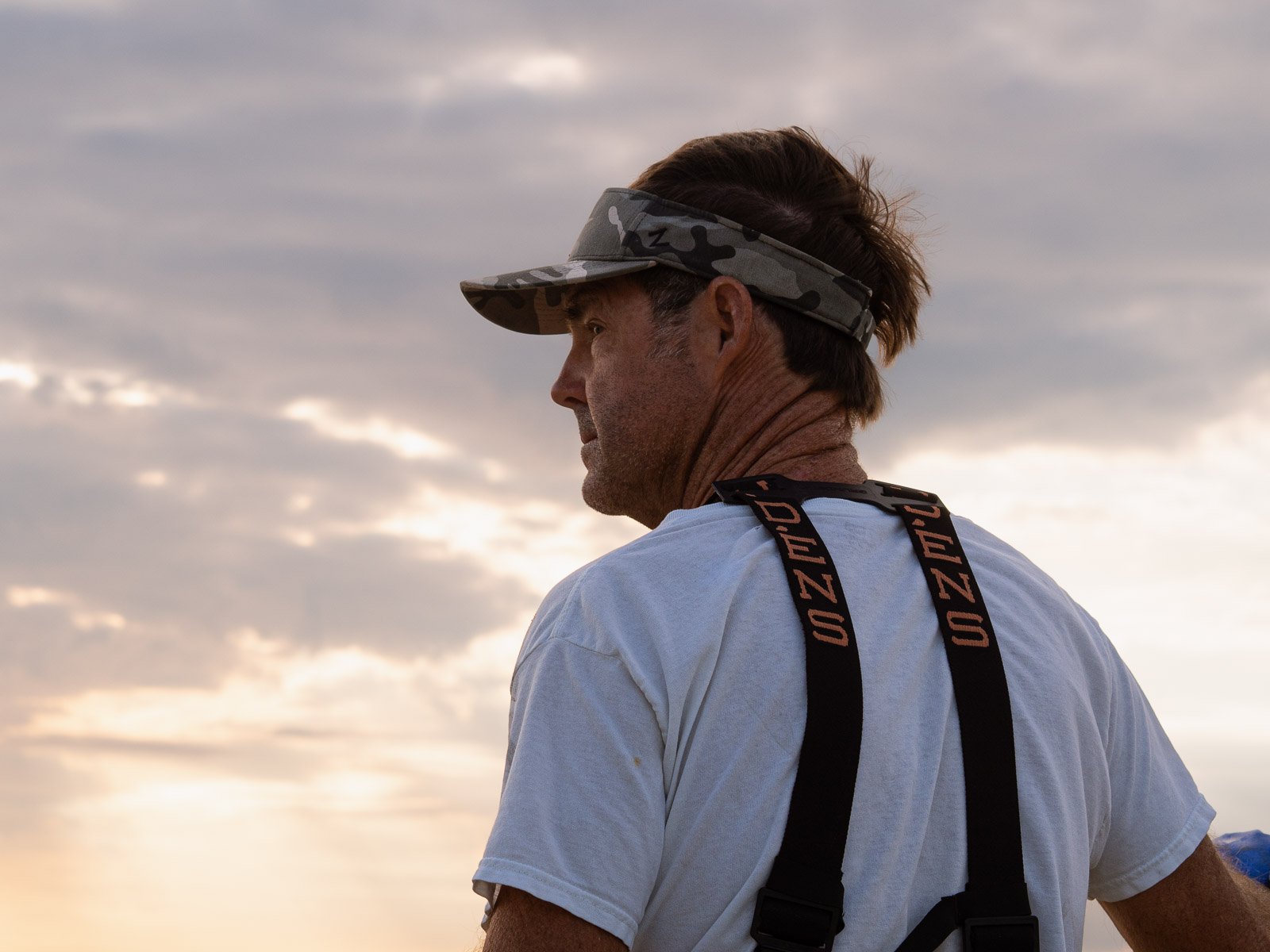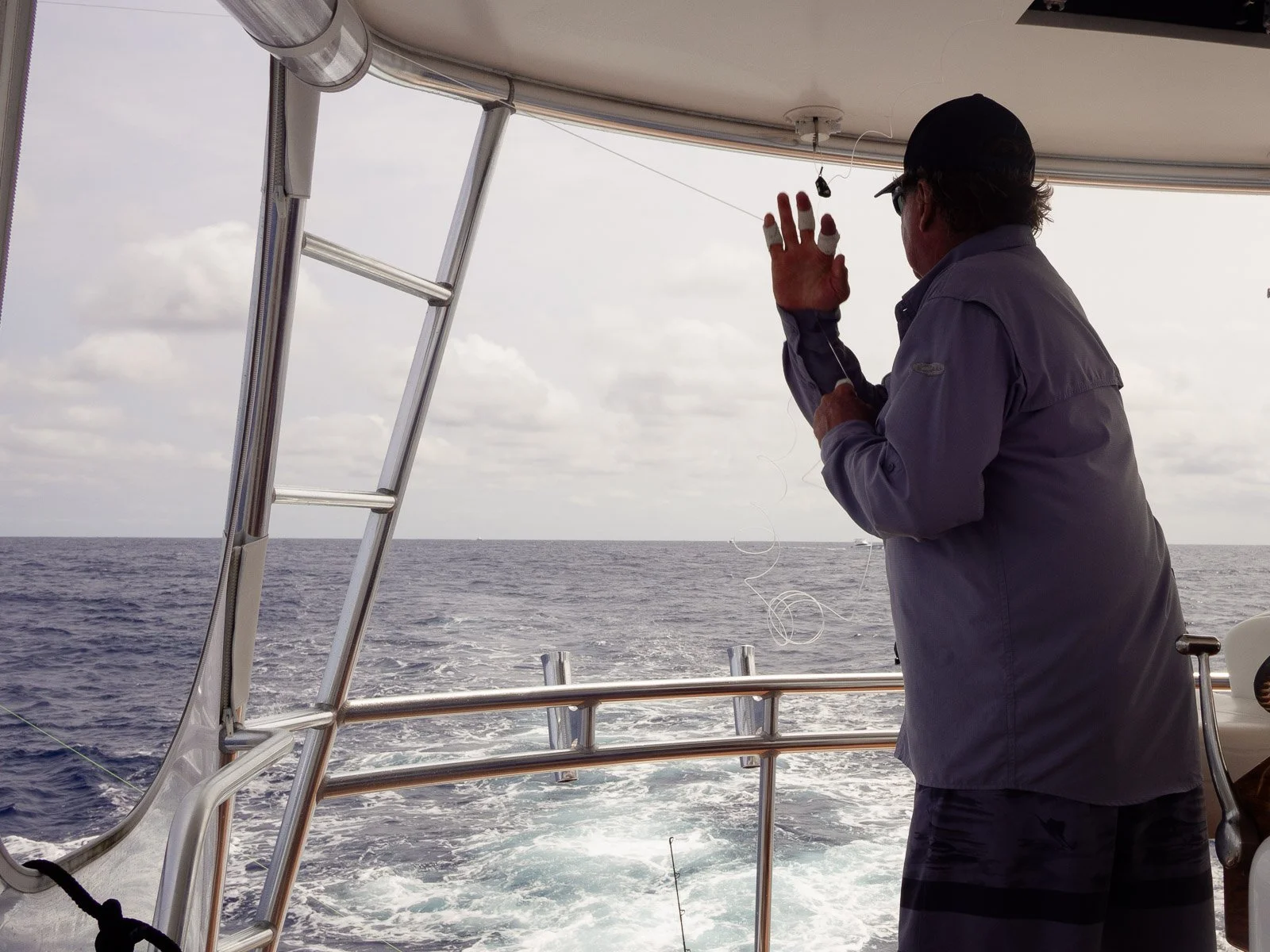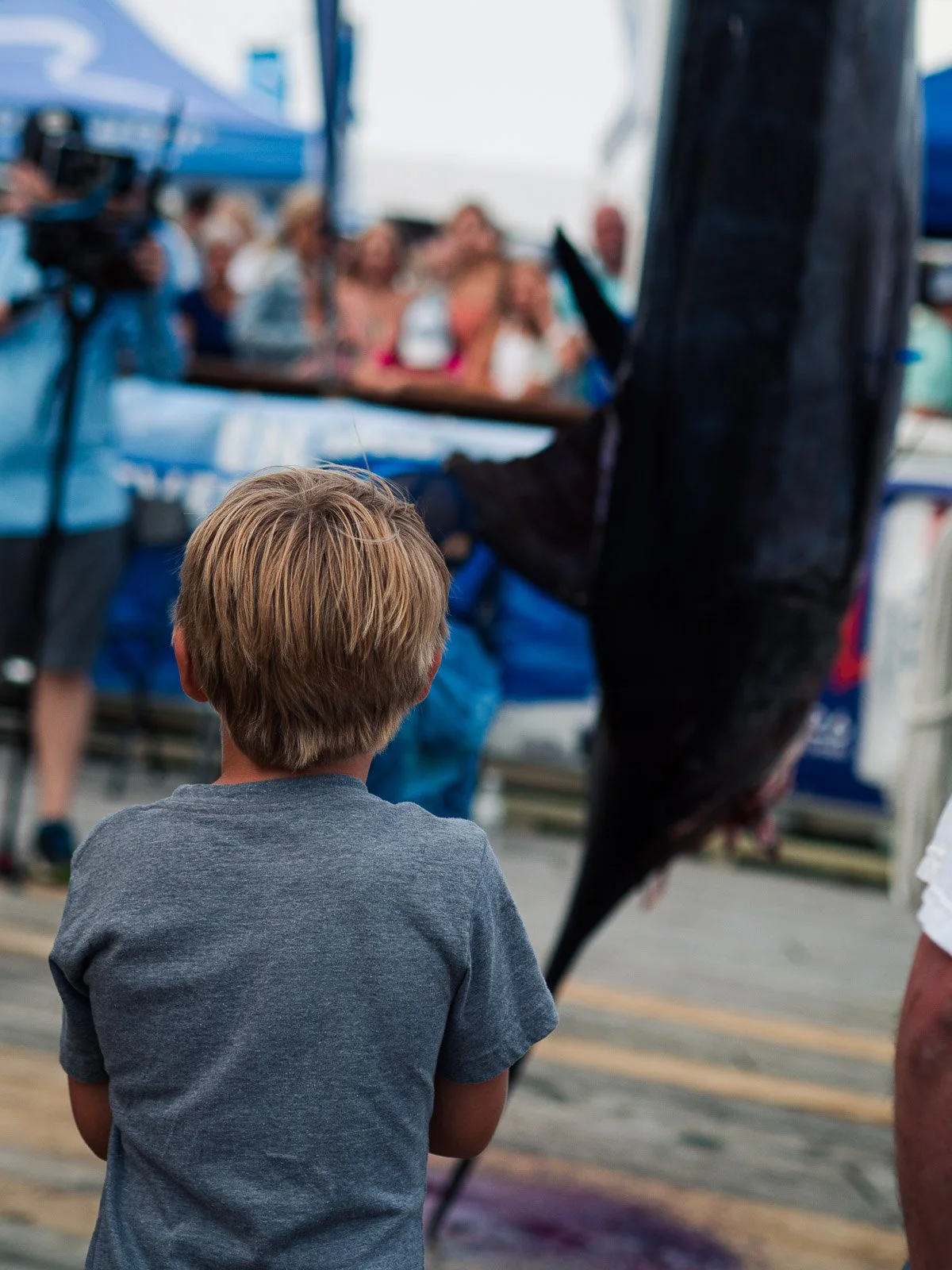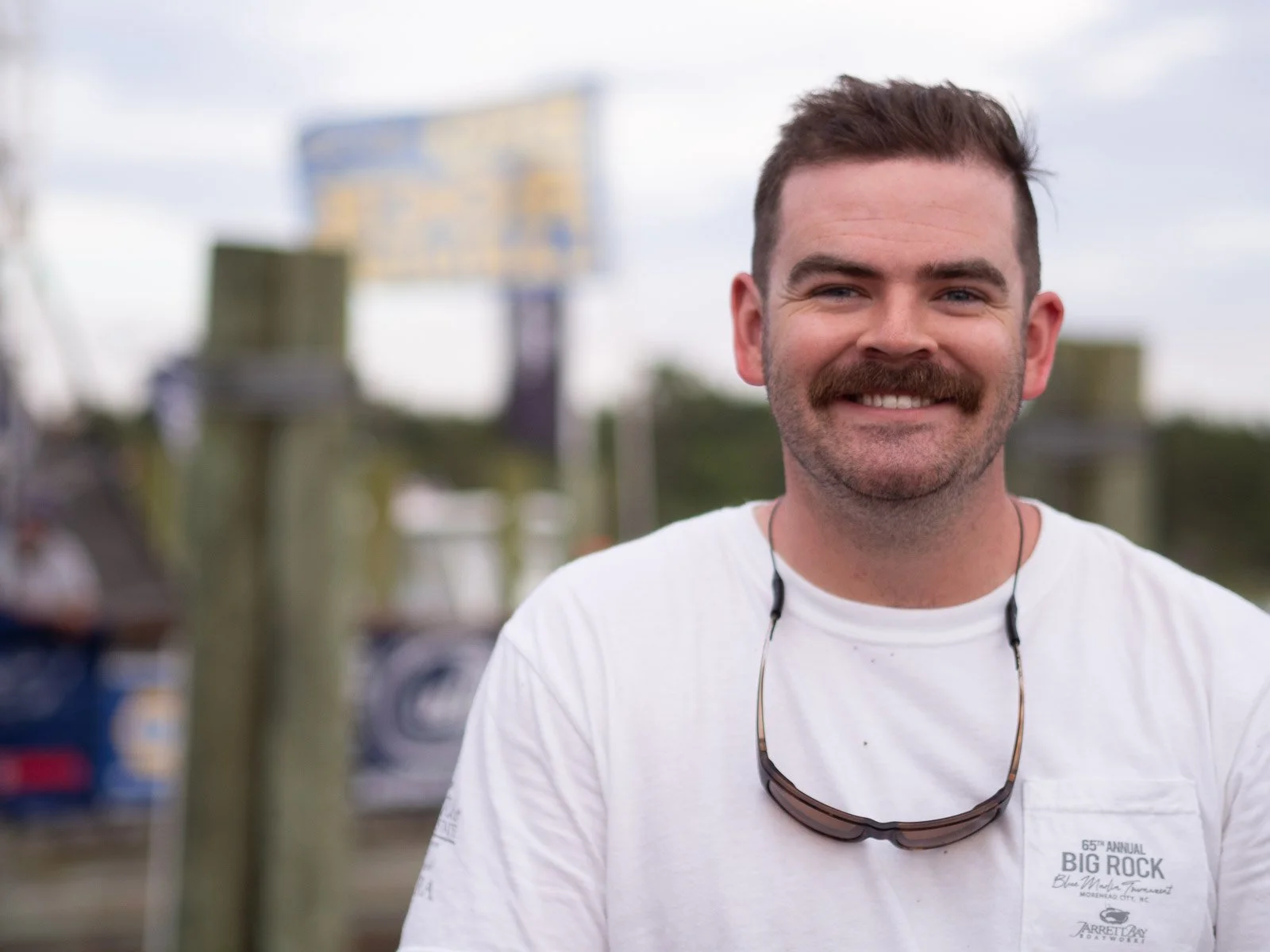
Navigating the Changing Waters of the Blue Crab Fishery:
Marc Mitchum’s Experience
Contesting on a Backdrop of Deep Blue Water
Heading south into the wind, captain Dale Britt navigates through crashing waves on the fifty-five foot vessel Weldor’s Ark. The day starts off early– we board the boat to journey to our fishing destination well before the sun rises to lather the sky with yellow, orange, and pink streaks. It is the fifth day of the 65th Big Rock Tournament 2023 and 255 of the 271 registered boats are on the hunt for game fishes. The swell of the sea and the leathering wind carries anticipation and excitement from vessel to vessel for miles offshore.
Each summer, anglers from near and far are drawn to the small North Carolina coastal town of Morehead City for the thrill of landing offshore fishes and large sums of prize money, all while contributing to the Big Rock Foundation’s charitable causes. Each year, the tournament gives away over a million dollars to various local organizations. On this hot June day in Carteret County, there are still open prize categories out of the total purse of $5,835,705, including the first blue marlin over 500 pounds. The largest fish so far: a 470.2 pound blue marlin “boated”, or captured and brought to shore, on day one by vessel C-Student (photo 1).
In the previous days, spectators of all ages (photo 2) poured to Big Rock Landing to witness the eight blue marlin, numerous dolphinfish, and wahoo landed. Despite the minimum tournament requirement of 400 pounds to land a blue marlin, three of these billfish had been brought in below this threshold so far in the 2023 tournament. The penalty for this violation: the largest blue marlin weighed in by these vessels in this year's tournament will have 400 pounds deducted from its total weight. This sportsfishing competition focuses on large landed marlin, while recognizing the importance of releasing billfish that will not make the leaderboard. Throughout the six-day event, a total of 248 billfish were successfully released.
Ellen Peel, the President of The Billfish Foundation, which advocates for the responsible use and conservation of billfish, stated that the majority of anglers today release their billfish. Peel reveals that this was not always the case: “Before [the 1970’s], there would be an array of billfish down the dock … just like wood cores … one after the other”.
Now, throughout all of the billfish tournaments in the U.S., only 250 marlin can legally be landed by anglers each year. Peel acknowledges the importance of using science for management such as relying on a stock assessment of blue marlin to indicate any changes in abundance. Stock assessments are a fisheries management tool that pools extant data sources to indicate the abundance status of a stock of fish. The most recent stock assessment for the Atlantic blue marlin indicates that the stock is overfished and experiencing overfishing.
On the tournament’s fifth day, patiently awaiting the 9 a.m. tournament start time, the Weldor’s Ark crew prepares the fishing gear (photo 3). The vessel smoothly transitions from confronting the waves and wind with the bow swaying side to side, a change made possible by its stabilizers. As a previous fishing charter captain for fifteen years on Jarrett Bay’s Sensation, Britt’s background
complements his involvement with the tournament. For 33 years, his competitive edge and passion for charity have led him to participate in the Big Rock tournament. On the boats, there's a diverse mix of individuals, ranging from locals participating in the fishing tournament to people traveling from around the world. Boat owners, recreational fishers, commercial fishers, scientists–and even celebrities like Michael Jordan–unite from various walks of life in search of the elusive blue marlin and other game fishes like dolphinfish, tuna, and wahoo.
Photo 3: On the tournament’s fifth day, patiently awaiting the 9 a.m. tournament start time, the Weldor’s Ark crew prepared the fishing gear
Photo 4: With bandages hugging his fingers, made necessary from years of working a fishing teaser line, Britt slowly navigates through the deep blue water
Photo 5: As the animal reached the surface, Britt pulled the teaser lines to help direct its movement
Photo 1: A 470.2 pound blue marlin boated on day one by vessel C-Student
Photo 2: In the previous days, spectators of all ages poured to Big Rock Landing to witness the eight docked blue marlin and numerous dolphin and wahoo
As the Gulf Stream diverts away from the coast near Cape Hatteras, N.C. there is a biogeographic barrier with cold water above and subtropical water below. Big Rock participants often orient near the Gulf Stream where the unique physical characteristics can lead to suitable blue marlin fishing habitat. To catch a blue marlin, knowledge on physical oceanography and ecology, experience on the water, sturdy gear, and ample patience is needed.
Once the crew of Weldor’s Ark sets up their fishing tackle near this warm current, it is time to exercise the necessary patience. Throughout the hours of waiting, our eyes stay on the open ocean or the sonar. With bandages hugging his fingers, made necessary from years of working a cutting fishing teaser line, Britt slowly navigates through the deep blue water (photo 4). To catch a blue marlin, artificial lures trail behind on the water’s surface to draw these billfish in from the depths. Though blue marlin have a regulating eye mechanism that allows them to see in deep, cold water, they are commonly found in surface waters down to 100 meters in depth due to temperature preferences.
All of a sudden, there is action on the sonar and they begin following the movements of a presumed blue marlin. As the animal reaches the surface, Britt pulls the teaser lines (photo 5) to help direct its movement. Just as it appears, it disappears back below the surface, spooked by a fishing line around its bill. Although they do not land a fish on this day of the tournament, Weldor’s Ark did tag and release two blue marlin during the 2023 Big Rock Tournament. The vessel and its crew went on to win the 2023 N.C. Billfish Series, which totals the points from releasing or landing billfish across seven tournaments.
Billfish tournaments present an opportunity for scientists to learn about these offshore animals by taking samples from a “boated” fish or by tracking live movements with data collected through a pop-up satellite tag. The Center for Marine Sciences and Technology (CMAST) in Morehead City, North Carolina is responsible for processing samples from blue marlin caught during the Big Rock Tournament. Ryan Tharp, graduate student in Dr. Jeff Buckel’s lab at CMAST, led this year’s sampling efforts (photo 6) alongside research volunteers. They collect a variety of samples such as ovaries, liver, and muscle tissue to send to other researchers working on this highly migratory species across the U.S. They identify stomach contents to learn about the diet habits of blue marlin and study mercury levels in the muscle tissue to examine if these billfish are safe for human consumption. During the week of the tournament, these researchers are working around the clock to take samples, freeze them, and ship them to places like Florida, California, and Texas. As Tharp states “[Blue marlin] are a rare fish to find and get your hands on'' so having the opportunity to study these animals up close is a unique chance to further their conservation. Chloe Mikles, a graduate student at Stanford University, joined Weldor’s Ark during the tournament to attach satellite tags to blue marlin designated for release. A satellite tag tells researchers the position of a blue marlin in the water at any given time.
Accompanying cutting-edge science, and fierce competition with large sums of prize money, The Big Rock Tournament helps shape the culture of Carteret County and is an “economic engine”, says Jerry Jones, the mayor of Morehead City. He mentions that it “puts Morehead City on the map” where fishing practices date back to at least the 18th century. “We have a lot of fishing heritage”, Jones says. We are all one big happy fishing county”.
Photo 6: Ryan Tharp, a graduate student in Dr. Jeff Buckel’s lab at CMAST, led this year’s sampling efforts





